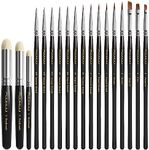Buying Guide for the Best Acrylic Paint Brushes
Choosing the right acrylic paint brushes can make a big difference in your painting experience and results. The right brush helps you control your strokes, blend colors smoothly, and achieve the effects you want. When shopping for acrylic paint brushes, it's important to understand the different features and how they relate to your painting style and needs. By learning about the key specifications, you can select brushes that will help you enjoy painting and improve your artwork.Bristle TypeBristle type refers to the material used for the brush hairs, which can be synthetic or natural. Synthetic bristles are usually made from nylon or polyester and are popular for acrylic painting because they hold up well to the chemicals in acrylic paint and are easy to clean. Natural bristles, often made from animal hair, are softer and more absorbent but can wear out faster with acrylics. If you want a brush that lasts longer and is easy to maintain, synthetic is a good choice. If you prefer a softer touch and work with thinner paint, you might try natural bristles, but be aware they may not last as long.
Brush ShapeBrush shape describes the form of the brush tip, such as flat, round, filbert, fan, or angular. Each shape creates different effects: flat brushes are great for bold strokes and filling large areas, round brushes are good for detail and lines, filbert brushes offer a blend of both, fan brushes are used for textures, and angular brushes help with sharp edges. To pick the right shape, think about the kind of painting you do most—if you like detailed work, go for round or small filbert brushes; for backgrounds or big areas, flat or large brushes are better.
Brush SizeBrush size is usually indicated by a number and refers to the width or diameter of the brush tip. Smaller numbers mean finer, smaller brushes for detail work, while larger numbers are for broad strokes and covering more area. The right size depends on the scale of your painting and the level of detail you want. If you paint small canvases or do intricate work, choose smaller sizes; for large canvases or backgrounds, larger brushes will save you time and effort.
Handle LengthHandle length can be short or long. Short handles are easier to control and are often used for close-up, detailed work, while long handles are designed for painting at an easel and allow for broader, sweeping strokes. If you paint at a table or like to work up close, short handles are more comfortable. If you stand at an easel or want more freedom of movement, long handles are a better fit.
Ferrule QualityThe ferrule is the metal part that holds the bristles to the handle. A good quality ferrule is tightly crimped and made from rust-resistant metal, which keeps the bristles secure and prevents shedding. If you want brushes that last and don’t lose hairs in your paint, look for brushes with sturdy, well-attached ferrules.



















